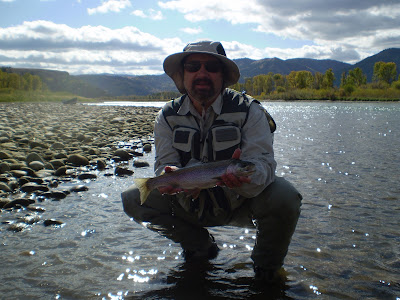The day started out calm, bright and clear. Looking around the camp it looked like the skunk hadn’t done any damage. We floated around the next bend in the river were the river forked. Where the two forks came back together there was some deep, slack water next to fast water flowing by.
Using Pale Morning Dun dry flies again, we cast right next to the fast water and ended up catching ten or so cutthroats.
These weren’t big fish but they were sure fun to catch and it was a nice way to start the day.
Another fun spot was a mile or so down the river across from a cabin. Again there was some deep water right where another fork entered the main river. This is where we had lunch. By now we had finished all our yummy pastrami, roast beef and cheese sandwiches and only had peanut butter and honey sandwiches left. I fished downstream where there was turbulence caused by the other fork while Nick fished upstream where the river became deep and fast. I didn’t even get a bite. Meanwhile Nick had a strike from a large trout and he kept fishing in the same spot, hoping it would strike again or if one big trout likes a certain spot, chances are another one will too.
There are a few cliffs along this stretch. Each time we would pass another section near cliffs it would seem like déjà vu because they all look the same. We kept taking turns rowing and fishing. We kept catching a few here and there.
We were fortunate in seeing another moose and another golden eagle.
As the day wore on, the wind kept picking up.
By the time we got near the camp spot at mid-afternoon, the wind was really making it difficult to cast. We kept our eyes open for the Wolf Flat ramp or camp spot. We even stopped were we thought it should be.
I walked back along the shore to ask another couple of fisherman if that was the camp. They said Wolf Flat was still around the next bend. Around the next bend there was still no ramp. Nick and I discussed our options. By this point it was too windy to fish and didn’t show any signs of letting up.
We decided to just row the additional four miles to our takeout point at Byington Poplar since we weren’t going to be fishing the next day anyway. We would be in a hurry to get home for the party celebrating Porter’s, Brooke’s, Janessa’s and Nick’s birthday’s which all occur during the month of October.
I started rowing hard toward our destination. It felt like I was rowing uphill against the wind. Nick then volunteered to row. We did pass a couple other campgrounds through this section that we were unaware of. These were called Rattlesnake Point and Clark Hill. If we hadn’t decided to just go home for the night these would have worked out well. In fact, I marked these sites on my map and we will keep them in mind for future trips.
At the take out at Byington, there is a metal box where you can place your rainbow trout heads to participate in an incentive program. The aim of this program is to reduce the number of rainbow trout in the river. The cutthroat trout are the native trout of the river. The rainbows compete with them and also breed with them, diluting the gene pool.
After a long day of rowing, 12 miles, Nick and I were anxious to hit the Golden Corral again. We ended up getting home at 1:00 in the morning. In the end, it was a good thing we came home Friday night. This gave us time to unpack, do laundry and put everything away before the party. It also gave Nick time to get packed and head for the airport at 5:30 Sunday morning. Unloading the cooler in the morning we were pleased to find that there were still big chunks of ice left and that the milk was nice and cold.
What was my favorite part of the trip? The first thing that comes to mind is Nick having so much success with dry flies that he tied himself. The biggest trout of the trip were caught on Nick’s dry flies.


































